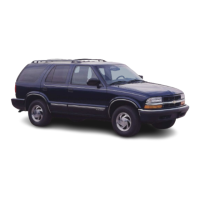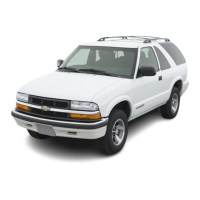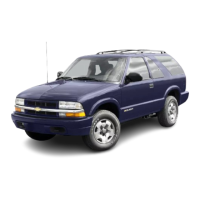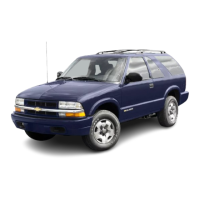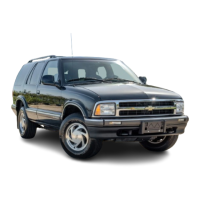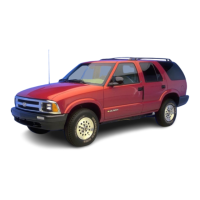Do you have a question about the Chevrolet BLAZER 2002 and is the answer not in the manual?
Adjusting front seats, lumbar support, power seats, memory seats, heated seats, reclining seatbacks, head restraints, and seatback latches.
Proper wear, use during pregnancy, cargo area safety, and how safety belts work.
Explanation of the air bag system, its operation, and cautions for occupants.
Importance of child protection, legal requirements, and appropriate restraints for infants and children.
Illustrates and explains common mistakes in wearing shoulder belts.
Explains incorrect lap belt placement and its dangers.
Explains wearing the shoulder belt under the arm and its risks.
Explains the danger of a twisted seat belt.
Explains the driver and passenger air bag locations and functions.
Describes post-inflation effects like dust, heat, and system replacement.
Information on infant car beds, a special bed for vehicle use.
Provides restraint with seating surface against infant's back.
Provides restraint with harness and shields.
How booster seats improve safety belt fit for children.
Warning against two children wearing the same belt.
Advice on shoulder belt positioning for small children.
Warning about shoulder belt placement behind the child.
Information on using a safety belt extender if needed.
Operation of manual and power windows, express-down, and lockout features.
Information on vehicle keys, ignition positions, and security.
Operation of door locks, security, and child safety.
Configuring auto lock/unlock features for different scenarios.
Operation of remote keyless entry transmitters.
Tips on preventing vehicle theft, including key security and parking strategies.
How the Passlock system disables fuel if tampering is detected.
Procedures for starting automatic and manual transmissions, including V6 engine specific steps.
Explanation of shift lever positions and electronic indicators.
Operation of the four-wheel drive system and electronic transfer case.
Overview of the instrument panel components and their functions.
Description of warning lights and gauges that signal vehicle issues.
How to read the coolant temperature gauge and what overheating means.
Explanation of the Service Engine Soon/Check Engine light and OBD II system.
Reading the oil pressure gauge and cautions about low oil pressure.
Explains the brake system warning light and ABS warning light.
Function of the security light and Passlock system.
Indicates potential problems with the 4WD system.
How to read the fuel gauge and common owner questions.
Understanding the low fuel light and DIC operations (temp, compass, trip).
Adjusting compass variance for accurate readings.
Accessing and resetting trip computer data (economy, range, fuel used, speed).
Operating the climate control system including fan, temperature, and mode knobs.
Tips for efficient air conditioning use on hot and cool days.
Tips for effective heating and using defrost mode for visibility.
Operating the rear window defogger and heated mirrors.
Using vent mode for outside air and directing airflow.
General introduction to the audio system and clock setting procedures.
Playing the radio, using Power, Volume, and RECALL controls.
Tuning, seeking, and scanning radio stations.
Saving favorite radio stations to pushbuttons.
Adjusting bass and treble levels.
Balancing sound between speakers and adjusting fade.
Understanding radio messages like CAL and LOC, and basic radio operation.
Loading and playing cassette tapes, controls, and error messages.
Using CD adapter kits with cassette players.
Radio operation with cassette player and Bose system.
Regular cleaning of the cassette player and proper tape storage.
Troubleshooting common CD changer errors like ERR.
How THEFTLOCK prevents radio theft.
Steps to enter a secret code to activate the THEFTLOCK system.
Procedures for unlocking after power loss and disabling the THEFTLOCK system.
Using steering wheel buttons to control radio functions.
Factors affecting AM and FM radio reception.
Advice on safe listening levels and precautions when adding aftermarket sound equipment.
Proper handling and storage of CDs.
Advice against using CD lens cleaner discs.
Operation of a six-disc CD player with EQ and RDS.
Radio controls including Power, Volume, AUTO VOL.
Tuning, seeking, and scanning radio stations.
Saving favorite stations to pushbuttons.
Adjusting bass and treble levels.
Adjusting sound balance and fade.
RDS features for seeking stations and receiving announcements.
Searching for stations by Program Type.
Automatically switching to stronger stations.
Loading discs into the changer and initial playback.
Selecting and playing specific CDs from the changer.
Using Random, NEXT, REV, FWD, SEEK for CD playback.
Allowing rear passengers to control audio sources independently.
Operation of the remote cassette player.
Operation of the console-mounted CD changer.
Step-by-step process for loading discs into the magazine and changer.
Troubleshooting common CD changer errors like ERR.
Factors affecting vehicle performance and driver responsibility.
Emphasizes seat belt use, speed control, and avoiding impairment.
Factors influencing driving, including weather, visibility, and vehicle design.
Advice on anticipating hazards, maintaining following distance, and being ready for unexpected events.
Risks of alcohol impairment on judgment, coordination, vision, and attentiveness.
Factors influencing BAC and legal limits in different regions.
How brakes, steering, and accelerator work together and the importance of tire-road contact.
Understanding perception and reaction time, stopping distances, and factors affecting them.
Function of ABS, system check, and warning light indicators.
How the ABS computer controls braking pressure and aids steering.
How steering works and tips for driving on curves.
Tips for off-road driving, including terrain familiarity and vehicle preparation.
Pre-off-road checks, maintenance, fuel, and legal considerations.
Practicing off-road driving skills, tuning senses, and controlling speed.
Assessing surface conditions, obstacles, and terrain changes.
Considerations for driving up, down, or across hills, including steepness and safety.
What to do if the vehicle stalls on a hill, including not attempting to rev the engine.
Cautions and techniques for driving downhill safely.
Techniques for driving in low-traction conditions.
Cautions and procedures for driving through water.
Tips for increasing safety in city driving, including route planning and traffic signals.
Advice on safe freeway driving, including merging, lane changes, and following distance.
Vehicle preparation and checks before embarking on a long journey.
Recognizing and preventing highway hypnosis and driver fatigue.
Considerations for driving on steep hills or mountains.
Recommendations for vehicle preparation and driving in snow or ice.
Important considerations for safe trailering, including laws, equipment, and vehicle preparation.
Understanding trailer weight, tongue weight, and Gross Combination Weight Rating (GCWR).
Importance of correct hitch equipment, sway control, and sealing holes after installation.
Proper attachment of safety chains and requirements for trailer brakes.
Cautions regarding rear window operation, exhaust fumes, and checks before and during towing.
Maintaining safe following distance and performing safe passes while trailering.
Advice on making wider turns and avoiding sharp maneuvers.
Procedures and cautions for parking a vehicle with a trailer on a hill.
Color code chart for connecting trailer wiring harness.
Using hazard flashers to warn others and reflective triangles.
Safe procedures for jump starting a vehicle with jumper cables.
Steps for safely changing a flat tire, including vehicle securing and tool usage.
Details on spare tire types, inflation, and usage cautions.
Techniques for rocking the vehicle to free it, using recovery hooks.
Identifying and responding to engine overheating, including steam and warning lights.
Identifying key components of the cooling system under the hood.
Understanding normal and abnormal engine fan noise.
What to do if a front or rear tire blows out.
Importance of dealer service, genuine GM parts, and keeping service records.
Recommended gasoline octane, specifications, and California fuel requirements.
Advice on fuel additives, methanol, and using fuel in foreign countries.
Procedures and cautions for refueling, including fuel cap installation.
Cautions regarding hot engine parts and flammable liquids.
Checking engine oil level, adding oil, and what kind of oil to use.
When to check and change automatic transmission fluid, and how to check the level.
When to check manual transmission fluid and cautions about fluid levels.
Checking clutch fluid level and identifying potential leaks.
When to check and change rear axle lubricant and how to check the level.
Checking lubricant levels for transfer case and front axle.
Information on DEX-COOL coolant, its properties, and cautions.
Importance of proper radiator cap installation to prevent coolant loss.
When to check power steering fluid and what type to use.
Checking windshield washer fluid level and adding fluid.
Information on DOT-3 brake fluid, reservoir checks, and cautions.
Understanding the high-pitched warning sound from worn brake pads.
Proper tightening of wheel nuts to prevent loosening and damage.
Cautions regarding tire maintenance, overloading, and wear.
Importance of correct tire inflation and potential issues from under/overinflation.
Procedures for tire rotation, inspection, and alignment checks.
Identifying when tires need replacement based on treadwear indicators and damage.
Guidelines for selecting and purchasing new tires, including TPC Spec numbers.
Understanding tire grading systems for treadwear, traction, and temperature.
Importance of proper wheel alignment and balance for tire life and performance.
Cleaning interior plastic, wood panels, fabric/carpet, and leather surfaces.
Cleaning windshield, backglass, wiper blades, and washing the vehicle.
Protecting paint finish, using proper cleaners, and avoiding damage.
Cleaning and polishing bright metal parts, including aluminum wheels.
Ensuring proper anti-corrosion treatment during sheet metal repairs.
Cautions regarding adding electrical equipment and circuit breaker protection.
Locating and understanding the instrument panel and engine compartment fuse blocks.
Engine, transmission, fluid, and tire specifications.
Information on refrigerant type and capacity for the air conditioning system.
Importance of proper maintenance for vehicle condition and environmental protection.
Overview of the five parts of the maintenance schedule section.
Maintenance intervals and services for vehicles driven under severe conditions.
Maintenance intervals and services for vehicles driven under normal conditions.
Owner checks and services to be performed at specified intervals.
Inspections and services recommended at least twice a year.
List of recommended fluids and lubricants by usage and part number.
Template for recording maintenance performed on the vehicle.
Steps to follow if concerns are not resolved by the dealership.
Contact details for Chevrolet Customer Assistance offices and TTY users.
Program details for reimbursement of adaptive equipment and resource information.
Information on the free roadside assistance program, including Basic Care and Courtesy Care.
Available transportation options when vehicle requires warranty service.
How to report safety defects to NHTSA (US) and Transport Canada (Canada).
Contact information for reporting vehicle safety defects directly to General Motors.
Information on ordering service manuals, bulletins, and owner's information.
Adjusting front seats, lumbar support, power seats, memory seats, heated seats, reclining seatbacks, head restraints, and seatback latches.
Proper wear, use during pregnancy, cargo area safety, and how safety belts work.
Explanation of the air bag system, its operation, and cautions for occupants.
Importance of child protection, legal requirements, and appropriate restraints for infants and children.
Illustrates and explains common mistakes in wearing shoulder belts.
Explains incorrect lap belt placement and its dangers.
Explains wearing the shoulder belt under the arm and its risks.
Explains the danger of a twisted seat belt.
Explains the driver and passenger air bag locations and functions.
Describes post-inflation effects like dust, heat, and system replacement.
Information on infant car beds, a special bed for vehicle use.
Provides restraint with seating surface against infant's back.
Provides restraint with harness and shields.
How booster seats improve safety belt fit for children.
Warning against two children wearing the same belt.
Advice on shoulder belt positioning for small children.
Warning about shoulder belt placement behind the child.
Information on using a safety belt extender if needed.
Operation of manual and power windows, express-down, and lockout features.
Information on vehicle keys, ignition positions, and security.
Operation of door locks, security, and child safety.
Configuring auto lock/unlock features for different scenarios.
Operation of remote keyless entry transmitters.
Tips on preventing vehicle theft, including key security and parking strategies.
How the Passlock system disables fuel if tampering is detected.
Procedures for starting automatic and manual transmissions, including V6 engine specific steps.
Explanation of shift lever positions and electronic indicators.
Operation of the four-wheel drive system and electronic transfer case.
Overview of the instrument panel components and their functions.
Description of warning lights and gauges that signal vehicle issues.
How to read the coolant temperature gauge and what overheating means.
Explanation of the Service Engine Soon/Check Engine light and OBD II system.
Reading the oil pressure gauge and cautions about low oil pressure.
Explains the brake system warning light and ABS warning light.
Function of the security light and Passlock system.
Indicates potential problems with the 4WD system.
How to read the fuel gauge and common owner questions.
Understanding the low fuel light and DIC operations (temp, compass, trip).
Adjusting compass variance for accurate readings.
Accessing and resetting trip computer data (economy, range, fuel used, speed).
Operating the climate control system including fan, temperature, and mode knobs.
Tips for efficient air conditioning use on hot and cool days.
Tips for effective heating and using defrost mode for visibility.
Operating the rear window defogger and heated mirrors.
Using vent mode for outside air and directing airflow.
General introduction to the audio system and clock setting procedures.
Playing the radio, using Power, Volume, and RECALL controls.
Tuning, seeking, and scanning radio stations.
Saving favorite radio stations to pushbuttons.
Adjusting bass and treble levels.
Balancing sound between speakers and adjusting fade.
Understanding radio messages like CAL and LOC, and basic radio operation.
Loading and playing cassette tapes, controls, and error messages.
Using CD adapter kits with cassette players.
Radio operation with cassette player and Bose system.
Regular cleaning of the cassette player and proper tape storage.
Troubleshooting common CD changer errors like ERR.
How THEFTLOCK prevents radio theft.
Steps to enter a secret code to activate the THEFTLOCK system.
Procedures for unlocking after power loss and disabling the THEFTLOCK system.
Using steering wheel buttons to control radio functions.
Factors affecting AM and FM radio reception.
Advice on safe listening levels and precautions when adding aftermarket sound equipment.
Proper handling and storage of CDs.
Advice against using CD lens cleaner discs.
Operation of a six-disc CD player with EQ and RDS.
Radio controls including Power, Volume, AUTO VOL.
Tuning, seeking, and scanning radio stations.
Saving favorite stations to pushbuttons.
Adjusting bass and treble levels.
Adjusting sound balance and fade.
RDS features for seeking stations and receiving announcements.
Searching for stations by Program Type.
Automatically switching to stronger stations.
Loading discs into the changer and initial playback.
Selecting and playing specific CDs from the changer.
Using Random, NEXT, REV, FWD, SEEK for CD playback.
Allowing rear passengers to control audio sources independently.
Operation of the remote cassette player.
Operation of the console-mounted CD changer.
Step-by-step process for loading discs into the magazine and changer.
Troubleshooting common CD changer errors like ERR.
Factors affecting vehicle performance and driver responsibility.
Emphasizes seat belt use, speed control, and avoiding impairment.
Factors influencing driving, including weather, visibility, and vehicle design.
Advice on anticipating hazards, maintaining following distance, and being ready for unexpected events.
Risks of alcohol impairment on judgment, coordination, vision, and attentiveness.
Factors influencing BAC and legal limits in different regions.
How brakes, steering, and accelerator work together and the importance of tire-road contact.
Understanding perception and reaction time, stopping distances, and factors affecting them.
Function of ABS, system check, and warning light indicators.
How the ABS computer controls braking pressure and aids steering.
How steering works and tips for driving on curves.
Tips for off-road driving, including terrain familiarity and vehicle preparation.
Pre-off-road checks, maintenance, fuel, and legal considerations.
Practicing off-road driving skills, tuning senses, and controlling speed.
Assessing surface conditions, obstacles, and terrain changes.
Considerations for driving up, down, or across hills, including steepness and safety.
What to do if the vehicle stalls on a hill, including not attempting to rev the engine.
Cautions and techniques for driving downhill safely.
Techniques for driving in low-traction conditions.
Cautions and procedures for driving through water.
Tips for increasing safety in city driving, including route planning and traffic signals.
Advice on safe freeway driving, including merging, lane changes, and following distance.
Vehicle preparation and checks before embarking on a long journey.
Recognizing and preventing highway hypnosis and driver fatigue.
Considerations for driving on steep hills or mountains.
Recommendations for vehicle preparation and driving in snow or ice.
Important considerations for safe trailering, including laws, equipment, and vehicle preparation.
Understanding trailer weight, tongue weight, and Gross Combination Weight Rating (GCWR).
Importance of correct hitch equipment, sway control, and sealing holes after installation.
Proper attachment of safety chains and requirements for trailer brakes.
Cautions regarding rear window operation, exhaust fumes, and checks before and during towing.
Maintaining safe following distance and performing safe passes while trailering.
Advice on making wider turns and avoiding sharp maneuvers.
Procedures and cautions for parking a vehicle with a trailer on a hill.
Color code chart for connecting trailer wiring harness.
Using hazard flashers to warn others and reflective triangles.
Safe procedures for jump starting a vehicle with jumper cables.
Steps for safely changing a flat tire, including vehicle securing and tool usage.
Details on spare tire types, inflation, and usage cautions.
Techniques for rocking the vehicle to free it, using recovery hooks.
Identifying and responding to engine overheating, including steam and warning lights.
Identifying key components of the cooling system under the hood.
Understanding normal and abnormal engine fan noise.
What to do if a front or rear tire blows out.
Importance of dealer service, genuine GM parts, and keeping service records.
Recommended gasoline octane, specifications, and California fuel requirements.
Advice on fuel additives, methanol, and using fuel in foreign countries.
Procedures and cautions for refueling, including fuel cap installation.
Cautions regarding hot engine parts and flammable liquids.
Checking engine oil level, adding oil, and what kind of oil to use.
When to check and change automatic transmission fluid, and how to check the level.
When to check manual transmission fluid and cautions about fluid levels.
Checking clutch fluid level and identifying potential leaks.
When to check and change rear axle lubricant and how to check the level.
Checking lubricant levels for transfer case and front axle.
Information on DEX-COOL coolant, its properties, and cautions.
Importance of proper radiator cap installation to prevent coolant loss.
When to check power steering fluid and what type to use.
Checking windshield washer fluid level and adding fluid.
Information on DOT-3 brake fluid, reservoir checks, and cautions.
Understanding the high-pitched warning sound from worn brake pads.
Proper tightening of wheel nuts to prevent loosening and damage.
Cautions regarding tire maintenance, overloading, and wear.
Importance of correct tire inflation and potential issues from under/overinflation.
Procedures for tire rotation, inspection, and alignment checks.
Identifying when tires need replacement based on treadwear indicators and damage.
Guidelines for selecting and purchasing new tires, including TPC Spec numbers.
Understanding tire grading systems for treadwear, traction, and temperature.
Importance of proper wheel alignment and balance for tire life and performance.
Cleaning interior plastic, wood panels, fabric/carpet, and leather surfaces.
Cleaning windshield, backglass, wiper blades, and washing the vehicle.
Protecting paint finish, using proper cleaners, and avoiding damage.
Cleaning and polishing bright metal parts, including aluminum wheels.
Ensuring proper anti-corrosion treatment during sheet metal repairs.
Cautions regarding adding electrical equipment and circuit breaker protection.
Locating and understanding the instrument panel and engine compartment fuse blocks.
Engine, transmission, fluid, and tire specifications.
Information on refrigerant type and capacity for the air conditioning system.
Importance of proper maintenance for vehicle condition and environmental protection.
Overview of the five parts of the maintenance schedule section.
Maintenance intervals and services for vehicles driven under severe conditions.
Maintenance intervals and services for vehicles driven under normal conditions.
Owner checks and services to be performed at specified intervals.
Inspections and services recommended at least twice a year.
List of recommended fluids and lubricants by usage and part number.
Template for recording maintenance performed on the vehicle.
Steps to follow if concerns are not resolved by the dealership.
Contact details for Chevrolet Customer Assistance offices and TTY users.
Program details for reimbursement of adaptive equipment and resource information.
Information on the free roadside assistance program, including Basic Care and Courtesy Care.
Available transportation options when vehicle requires warranty service.
How to report safety defects to NHTSA (US) and Transport Canada (Canada).
Contact information for reporting vehicle safety defects directly to General Motors.
Information on ordering service manuals, bulletins, and owner's information.
| Brand | Chevrolet |
|---|---|
| Model | BLAZER 2002 |
| Category | Automobile |
| Language | English |
